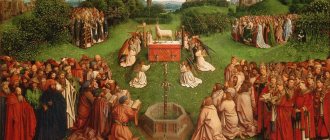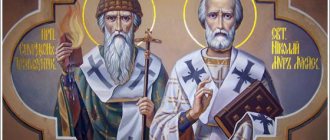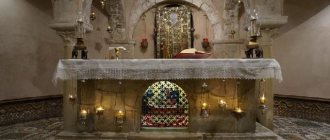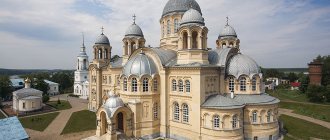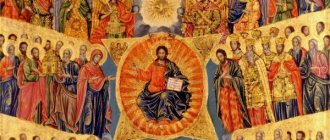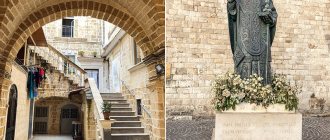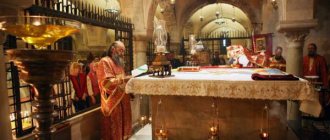“Christ is risen!”: conversation with the Kiev-Pechersk saints
One of the unique phenomena of the entire, not only Orthodox, world is the caves of the Kiev Pechersk Lavra. Created by the founders of the monastery, the Monks Anthony and Theodosius, in the 11th century. The Near and Far Caves today collectively contain more than 120 relics of the holy saints of God. There is, perhaps, no other place in the world where so many incorruptible remains of glorified saints are kept at the same time.
The caves also contain myrrh-streaming heads of unknown saints. The chapters are placed in special vessels, and from them a liquid substance of inexplicable origin is released - myrrh, which has healing properties. Moreover, when the heads stream myrrh, they become soft, like wax.
But the Lavra Caves can boast not only of the number of shrines. Other types of Orthodox miracles also happen in them. Some of them are described in the “Kievo-Pechersk Patericon” and are associated with the name of St. Mark, who labored here. His main obedience was to dig graves in the cave for newly deceased ascetics, for which he later received the nickname Grave Digger.
The Patericon mentions several unusual phenomena when the dead obeyed Mark and carried out his instructions. For example, he did not have time to dig a grave for one of the newly deceased holy fathers in time and asked through another monk to tell the deceased to wait. Then the incredible happened: when Mark’s request was conveyed to the monk, the dead man rose again and lived another day.
Another dead man, who was placed in a cramped grave so that it was impossible to approach him to smear his body with oil, at the request of Mark the Grave Digger, took the oil and doused himself with it. A case is also described when one of the deceased brothers, at the word of the same Mark, himself moved to another grave in order to give way to his brother, which was due to him according to seniority.
Today, the relics of St. Mark the Grave Digger rest in famous caves and are the subject of veneration. Not only the incorrupt remains of the saint have been preserved, but also chains, a cross and the famous hat. After the prayer service, it is placed on the head of everyone who wants it, which often results in healings and other miracles.
In 1453, another incident occurred in the caves, which can be classified as incredible. On the feast of the Resurrection of Christ, a priest named Dionysius came here. Overflowing with joy and wanting to share it with the saints, he exclaimed: “Today is a Great Day, holy fathers: Christ is risen!” Unexpectedly, the entire host of Pechersk saints clearly answered him: “Truly he is risen!” Dionysius was so amazed by this unusual phenomenon that he was speechless for a long time and spent the rest of his life in seclusion.
Why are relics preserved incorruptible?
Almost every religion has many testimonies of bodies that can “withstand the horrors of the grave.” The most ancient story about this phenomenon was found in the Chinese chronicles “The Lives of Buddhist Saints”. It talks about one of the most famous patriarchs of the Sun Dynasty, Gui Nene. He died in 712 and was buried in Kuo-en Monastery. During the fall of the Sun Dynasty, in 1276, Mongol warriors dug up the body, wanting to verify the truth of the rumors about its miraculous preservation. 564 years after his death, the master’s skin remained elastic and shiny, without any signs of drying or decomposition. Then the Mongols ripped open the body and saw that the heart and liver were in excellent condition. Completely stunned, they thought it best to immediately end the sacrilege and run away.
Another case dates back to 1977. A family crypt was opened in Espartinas (Spain). The gravedigger and his assistants were stunned to find the corpse of an 11-year-old child there, who was not touched by decomposition, although he had lain there for forty years. The boy José García Moreno died of meningitis in 1937, and the family decided not to embalm him. Soon the whole village came running to look at the “living” body under the decayed shroud. Deciding that José was the "chosen one" and therefore a saint, they petitioned Rome for his canonization. But the answer was negative - phenomena from the category of stigmata, clairvoyance, levitation and incorruptibility are not considered important in the Vatican.
The last case that KP wrote about (see issues for October 19, 2002, December 2 and 4, 2004) was the incorrupt body of the former head of Russian Buddhists, Khambo Lama Itigelov, who died 80 years ago. Medical experts were shocked: Itigelov had all the signs of a living body: soft skin without signs of rotting, his nose, ears, closed eyes (the eyeball did not leak out), his fingers and elbow joints were mobile. Even the “living” smell remained. This was confirmed by experts during examination. The famous chiropractor Alexei Azheev, who has been observing the body since 2002, even felt the pulsation of the brain in a special way. In his opinion, living cerebral hemispheres produce 3 - 4 rhythms per minute, and the motionless Itigelov - 1. Once every six months, he even, as if alive, gains and loses half a kilogram in weight. Now the lama sits under a glass cover in the Ivolginsky datsan (monastery). And on certain days there are long lines of people who want to touch the shrine.
AN INNOCENT VICTIM
What hypotheses are usually put forward as an alternative to belief in miracles? Various methods of embalming can be immediately rejected, since the results of medical research revealed that in the listed cases no protective measures were used and the entrails were not removed. The author of the book Incorruptible, Joan Cruz, identified three categories of preserved bodies: deliberately preserved; preserved by accident due to exposure to natural conditions; truly imperishable. Cases from the second category are very surprising, although they have a completely materialistic explanation. Researchers provide a considerable list of places known for the preservation of human remains. Thus, Cruz mentions the well-preserved mummy of an eight-year-old child found in a mountain cave in Chile. Apparently the boy was dragged up and left in the cold as a sacrifice 500 years ago. Completely undeteriorated bodies of Iron Age people were also found in peat bogs. They were only discolored due to natural chemical processes. Methods of preserving bodies using alcohol, formaldehyde, honey, sand, salt and numerous unusual mixtures, such as guano, are also known. But such bodies are not truly incorruptible.
SECRETS OF THE CHURCH BASEMENT
“Some places are chosen for cemeteries deliberately, because their natural conditions delay the processes of decomposition,” says Valery Grushin, candidate of historical sciences. “For example, the Capuchin catacombs in Palermo and Malta are known for their amazing specimens. They are dressed in the clothes of their time. Their skin and muscles dried out and hardened, as if they had turned to stone. Many of them have been there for more than two hundred and fifty years. But they never turned into skeletons.
The cellars of St. Michael's Church in Dublin have the same properties. There, for example, is the body of a baby, whose plump wrists are still wrapped in ribbons that have faded from the time of the funeral. And the year 1679 is indicated on the coffin. It is believed that this effect is caused by the extreme dryness of the air and the lack of dust. Similar conditions prevailed in the Kiev necropolis, where numerous dried bodies lay in open coffins. Now they are covered with glass lids.
Radiation is believed to be the reason for the preservation of bodies buried 250 years ago and discovered at Wasserburg-Somersdorf Castle in Germany. However, the extremely weak radiation actually detected in the castle crypt does not explain either the strange mummification or the complete lack of decomposition.
The incorruptibility of the relics can also be explained by a complex natural process called saponification, or saponification. The name itself suggests that under the skin, body tissues turn into ammonia soap. This substance is called adipocere (from the Latin adeps - “fat” and cera - “wax”) or graisse du cadavre (“cadaver fat” - French). This happens in the grave in wet soil conditions. It’s just not clear why this process occurs in some cases and not in others.
HEAVEN'S BLESS
“True incorruptibility does not depend on the condition of the body and burial conditions,” says Georgy Shishkovets, Doctor of Philosophy, specialist in church rituals. “For some reason, some bodies do not decompose in places where all others quickly turn to dust. The Church sees in this “the favor of heaven” for the pious soul. But cases when the remains can be considered truly incorrupt are extremely rare. Regardless of whether they fit into a religious context or not, these phenomena are characterized by similar features: an undecomposed body, a supernaturally persistent aroma, the presence of such paranormal effects as a glow around the coffin and the appearance of the deceased in the dreams of the living. Such a coincidence suggests the presence of some feature that changes ordinary reality. Moreover, the questions that arise, as a rule, rest on the nature of our mental and spiritual existence and even on the nature of reality itself.
Such a case went down in history. In late 1980, in the northern Nigerian city of Kano, government troops were called in to quell a rebellion raised by followers of a heretical Muslim cult led by the self-proclaimed prophet Muhammad Marwa. Marwa chose Kano as the location of his residence back in the 1960s and managed to gather ten thousand followers. In December 1980, disagreements between his sect and orthodox Muslims erupted into a riot that killed eight thousand people, including Marwa himself. At first, the leader's corpse was simply buried in a shallow grave. But three weeks later, the governor ordered his body to be exhumed and, covered with ice, placed in the city morgue. Then it turned out that Marva’s body was not subject to decomposition.
Mysteries of the God-created caves of the Pskov-Pechersky Monastery
The only thing that can compete in fame with the Lavra Caves of Kyiv is the “God-created caves” of the Pskov-Pechersk Monastery, which can also be considered one of the Orthodox miracles. They were opened in 1392, 80 years before the founding of the monastery itself.
And it happened like this. A peasant from this area was cutting down trees. Suddenly, one of the trees fell down the mountain, followed by several more, and the entrance to the caves opened under them. According to one legend, they were founded by monks from the Kiev Pechersk Monastery who fled from the Crimean Tatars. Above the entrance they found an inscription: “Caves created by God.” Later, one fool tried to erase this inscription, but it always appeared again. Today, many relics of saints from the monastery brethren rest in these caves.
The remains of the founders of the monastery are also buried here: priest John Shestnak and his wife Maria (in monastic vows - Vassa). When the latter died, her husband buried her at the entrance to the cave, burying the coffin underground. However, the next day he discovered the coffin in the same place, but on the surface. Having served the funeral service again, he buried the coffin again, but the same thing happened again. Then he realized that this was the will of God.
Since then, a tradition has been established: coffins with the dead are never buried in caves, but are left in special niches - crypts. But the unusual phenomena with the relics of nun Vassa did not end there. When at the beginning of the last century some attackers tried to open the coffin of the holy founder of the monastery, they failed: fire appeared from the coffin and burned them. Evidence of this posthumous miracle can still be seen on the coffin of the Monk Vassa - these are traces of the fire.
Not only monks, but also some lay people are buried in caves created by God. Among them there are even famous ancestors of Mussorgsky, Pushkin and Kutuzov. In total there are about ten thousand burials. Moreover, it is interesting that there are no smells of decay here.
Saint John Bosco
Died 1888
John Bosco, born August 16, 1815, was an Italian Catholic priest and educator who taught through a method based on love rather than punishment. Beatified June 2, 1929; canonized April 1, 1934; founder of the Salesian order. The saint is considered the protector of apprentices, editors, printers, and young people.
Posthumous miracle of Alexander Nevsky
An unusual phenomenon occurred in 1263 at the funeral service of the blessed prince Alexander Nevsky, who before his death adopted the schema with the name Alexy. At the moment when they were supposed to give him the permit, he himself, in front of everyone present, extended his hand and took it.
It is interesting that the same miracle was repeated exactly seven centuries later, when the funeral service was held for the great ascetic of our days, Schema-Archimandrite Vitaly (Sidorenko). Moreover, it is significant that this happened in the church in honor of Alexander Nevsky in Tbilisi on the eve of the day of memory of the blessed prince on December 5, 1992. Father Vitaly served in this church for the last years of his life. The reaction of those present to this unusual phenomenon was recorded during videotaping of the funeral service.
Almost alive: the relics of St. Alexander of Svirsky
Read also:
The miracle of holy relics: why do the Orthodox venerate them?
Another inexplicable miracle is the incorrupt remains of St. Alexander of Svirsky. As is known, he was the only Russian saint to whom the Holy Trinity appeared. The monk labored for many years in seclusion near the Svir River at the turn of the 16th century. The relics of the monk are unique in that they have been preserved almost completely incorruptible, including soft tissues, even those areas of the face that usually decay first.
From the ascetic’s feet comes a fragrant myrrh, to which bees flocked after the second acquisition. This miracle was captured on video cameras. Today the relics of the saint are in the Holy Trinity Alexander-Svirsky Monastery.
How Spyridon of Trimifuntsky turned over in his grave
They are famous for their numerous miracles and the relics of St. Spyridon of Trimythous. They are also marked by almost complete incorruption. Often the shrine with the relics of the saint cannot be opened: it is believed that he is not here at this time, as he helps the suffering. The same is evidenced by the famous velvet shoes of the ascetic, which have to be changed every year because their soles miraculously wear down.
But we would like to tell you about one more Orthodox miracle, which was witnessed by Nikolai Gogol, from whose lips this story came to us. One day the writer came to venerate the relics of St. Spyridon and saw the following unusual phenomenon.
When the remains of the saint, according to tradition, were carried around the city, among those present there was one pilgrim from England who doubted the authenticity of the miracle. He was sure that the body of the Trimifuntsky miracle worker was embalmed, and therefore there must be incisions on his back.
However, when he came closer to the relics to examine them, in front of everyone, the remains of the saint themselves rose in the coffin and turned over so that the Englishman could be sure that there were no seams there. After this, the saint’s relics also returned to their previous position.
The floating relics of Bishop Clement of Rome
Another unique posthumous miracle is associated with the name of Saint Clement of Rome, who died as a martyr in the 2nd century. His body was thrown into the sea with an anchor around his neck near Chersonesus. However, every year on the day of remembrance of the martyr, a completely unusual phenomenon took place: the sea parted for eight days, allowing people to approach the relics, and on each of these days the Liturgy was celebrated here. This continued until the remains of Clement were miraculously found in the 9th century by Equal-to-the-Apostles Cyril and Methodius.
Blessed John XXIII
Died 1963
Angelo Giuseppe Roncalli was born in northern Italy in the town of Sotto il Monte in the province of Bergamo on November 25, 1881. On October 28, 1958, Angelo Giuseppe was elected the two hundred and sixty-first Pope of the Catholic Church and became the oldest (at the time of election) pope of the twentieth century. He was beatified on September 3, 2000, along with Pope Pius IX.
The imperishable ear of John Chrysostom
The Vatopedi Monastery on Mount Athos contains another rare shrine - the venerable head of St. John Chrysostom. It is a bare skull without any skin. The surprising thing about it is that one part still remained incorruptible - this is the ear of the saint. Moreover, it is completely inexplicable how it can stay on bare bones. It is believed that the Apostle Paul himself whispered into this ear of John Chrysostom when he wrote interpretations of his letters. That is why it was preserved untouched by decay.
Afanasy Seated
In the Annunciation Cathedral in Kharkov there are the relics of St. Athanasius, the Wonderworker of Lubensky, resting in an unusual position for us - sitting. The people called him for this: “Athanasius the Seated.” What is the mystery of such an unusual burial? And how did the relics of the saint end up with us?
Athanasius was the Patriarch of Constantinople. In 1694, he was returning through Ukraine from Moscow, where he had gone on a personal errand to the Tsar. On the way, he became very ill and stopped at the Mgarsky monastery near Lubny in the Poltava region. Here he was buried according to the custom of burying Eastern patriarchs - sitting. Later, the relics of the saint were transported to Kharkov, where they became famous for their miracles.
Saint Veronica Giuliani
Died in 1727
Veronica Giuliani was born on December 27, 1660, Mercatello sul Metauro, Principality of Urbino, Italy into a wealthy family. At baptism she was named Ursula. According to the Catholic Encyclopedia, Veronica showed signs of holiness from a very early age. On June 17, 1802, Veronica Giuliani was canonized by Pope Pius VII, and on May 26, 1839, Pope Gregory XVI canonized her as a saint.
The posthumous smile of Joseph of Vatopedi
Orthodox miracles still occur today. One of them is the posthumous smile of the modern Athonite elder and ascetic Joseph of Vatopedi. He died on July 1, 2001. When the elder died, his face was not smiling, which is recorded in numerous photographs. However, later, when his body, according to Athonite custom, was sewn into a mantle, and then part of the fabric around his face was cut out, they saw an unusual phenomenon: the old man smiled such a peaceful smile that can only be on the happiest face. These photographs quickly spread across the Internet around the world.
We present to your attention a film about the second discovery of the incorruptible remains of St. Alexander of Svirsky:
What do holy remains look like?
According to human concepts, remains include either the skeleton of a deceased person or his incorruptible body. This is a deep misconception. Many saints died a martyr's death, some were burned, and only ashes remained, and some were torn to pieces by lions, leaving only a certain part of the body untouched.
Holy relics are different parts of the body, bones or ashes.
Holy relics
Holy remains also include incorruptible bodies, the most recognizable of which are:
- Sergius of Radonezh;
- St. Ambrose;
- St. Luke and many other saints.
Important! According to an innovation of the seventh century, worship in the temple can only be held where the relics of a saint are kept, who invisibly patronizes the temple and its parishioners.
